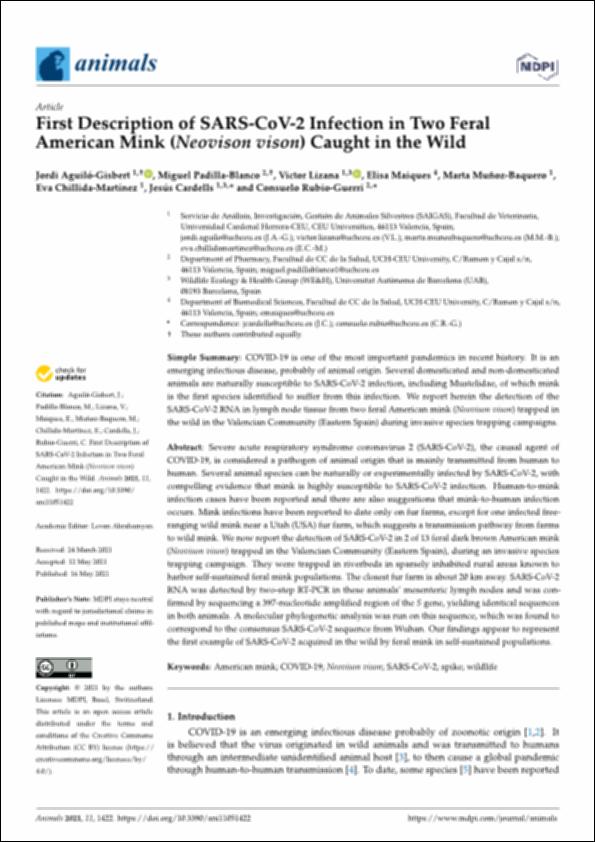Por favor, use este identificador para citar o enlazar este ítem:
http://hdl.handle.net/10637/13544First description of SARS-CoV-2 infection in two feral American Mink (Neovison vison) caught in the wild
| Título : | First description of SARS-CoV-2 infection in two feral American Mink (Neovison vison) caught in the wild |
| Autor : | Aguiló Gisbert, Jordi Padilla Blanco, Miguel Lizana Martín, Víctor Manuel Maiques Fernández, Elisa Muñoz Baquero, Marta Chillida Martínez, Eva Cardells Peris, Jesús Rubio Guerri, Consuelo |
| Materias: | Visones - Infecciones por coronavirus.; SARS-CoV-2 (Virus); Minks - Coronavirus infections.; Feral animals - Diseases.; COVID-19 (Disease); Animales salvajes - Enfermedades.; COVID-19. |
| Editorial : | MDPI |
| Citación : | Aguiló-Gisbert, J., Padilla-Blanco, M., Lizana, V., Maiques, E., Muñoz-Baquero, M., Chillida-Martínez, E., Cardells, J. & Rubio-Guerri, C. (2021). First description of SARS-CoV-2 infection in two feral American Mink (Neovison vison) caught in the wild. Animals, vol. 11, i. 5 (16 may.), art. 1422. DOI: https://doi.org/10.3390/ani11051422 |
| Resumen : | Severe acute respiratory syndrome coronavirus 2 (SARS-CoV-2), the causal agent of COVID-19, is considered a pathogen of animal origin that is mainly transmitted from human to human. Several animal species can be naturally or experimentally infected by SARS-CoV-2, with compelling evidence that mink is highly susceptible to SARS-CoV-2 infection. Human-to-mink infection cases have been reported and there are also suggestions that mink-to-human infection occurs. Mink infections have been reported to date only on fur farms, except for one infected freeranging wild mink near a Utah (USA) fur farm, which suggests a transmission pathway from farms to wild mink. We now report the detection of SARS-CoV-2 in 2 of 13 feral dark brown American mink (Neovison vison) trapped in the Valencian Community (Eastern Spain), during an invasive species trapping campaign. They were trapped in riverbeds in sparsely inhabited rural areas known to harbor self-sustained feral mink populations. The closest fur farm is about 20 km away. SARS-CoV-2 RNA was detected by two-step RT-PCR in these animals’ mesenteric lymph nodes and was confirmed by sequencing a 397-nucleotide amplified region of the S gene, yielding identical sequences in both animals. A molecular phylogenetic analysis was run on this sequence, which was found to correspond to the consensus SARS-CoV-2 sequence fromWuhan. Our findings appear to represent the first example of SARS-CoV-2 acquired in the wild by feral mink in self-sustained populations. |
| Descripción : | Este artículo se encuentra disponible en la siguiente URL: https://www.mdpi.com/2076-2615/11/5/1422 Este artículo pertenece a la sección "Wildlife". En este artículo de investigación también participan: Miguel Padilla-Blanco, Victor Lizana, Elisa Maiques, Marta Muñoz-Baquero, Eva Chillida-Martínez, Jesús Cardells y Consuelo Rubio-Guerri. |
| URI : | http://hdl.handle.net/10637/13544 |
| Derechos: | http://creativecommons.org/licenses/by/4.0/deed.es |
| ISSN : | 2076-2615 (Electrónico) |
| Fecha de publicación : | 16-may-2021 |
| Centro : | Universidad Cardenal Herrera-CEU |
| Aparece en las colecciones: | Dpto. Producción y Sanidad Animal, Salud Pública Veterinaria y Ciencia y Tecnología de los Alimentos |
Los ítems de DSpace están protegidos por copyright, con todos los derechos reservados, a menos que se indique lo contrario.


